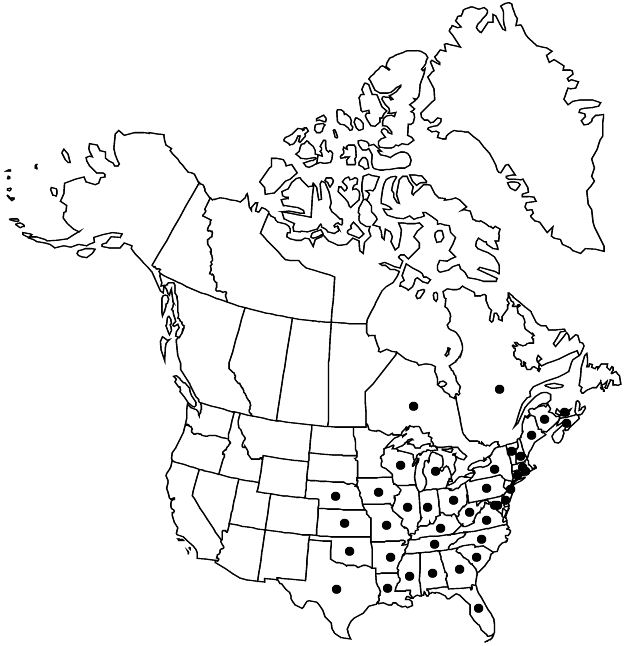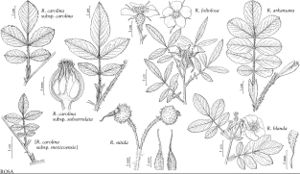Difference between revisions of "Rosa carolina subsp. carolina"
FNA>Volume Importer |
imported>Volume Importer |
||
| (6 intermediate revisions by 2 users not shown) | |||
| Line 1: | Line 1: | ||
{{Treatment/ID | {{Treatment/ID | ||
|accepted_name=Rosa carolina subsp. carolina | |accepted_name=Rosa carolina subsp. carolina | ||
| − | |accepted_authority= | + | |accepted_authority= |
|publications= | |publications= | ||
|basionyms= | |basionyms= | ||
| Line 7: | Line 7: | ||
|name=Rosa aucuparia | |name=Rosa aucuparia | ||
|authority=Rydberg | |authority=Rydberg | ||
| − | }}{{Treatment/ID/Synonym | + | |rank=species |
| + | }} {{Treatment/ID/Synonym | ||
|name=R. carolina var. grandiflora | |name=R. carolina var. grandiflora | ||
|authority=(Baker) Rehder | |authority=(Baker) Rehder | ||
| − | }}{{Treatment/ID/Synonym | + | |rank=variety |
| + | }} {{Treatment/ID/Synonym | ||
|name=R. carolina var. villosa | |name=R. carolina var. villosa | ||
|authority=(Best) Rehder | |authority=(Best) Rehder | ||
| − | }}{{Treatment/ID/Synonym | + | |rank=variety |
| + | }} {{Treatment/ID/Synonym | ||
|name=R. humilis | |name=R. humilis | ||
|authority=Ehrhart | |authority=Ehrhart | ||
| − | }}{{Treatment/ID/Synonym | + | |rank=species |
| + | }} {{Treatment/ID/Synonym | ||
|name=R. lyonii | |name=R. lyonii | ||
|authority=Rafinesque | |authority=Rafinesque | ||
| − | }}{{Treatment/ID/Synonym | + | |rank=species |
| + | }} {{Treatment/ID/Synonym | ||
|name=R. parviflora | |name=R. parviflora | ||
| − | |authority= | + | |authority= |
| − | }}{{Treatment/ID/Synonym | + | |rank=species |
| + | }} {{Treatment/ID/Synonym | ||
|name=R. serrulata | |name=R. serrulata | ||
| − | |authority= | + | |authority= |
| + | |rank=species | ||
}} | }} | ||
|hierarchy=Rosaceae;Rosaceae subfam. Rosoideae;Rosaceae tribe Roseae;Rosa;Rosa subg. Rosa;Rosa sect. Rosa;Rosa carolina;Rosa carolina subsp. carolina | |hierarchy=Rosaceae;Rosaceae subfam. Rosoideae;Rosaceae tribe Roseae;Rosa;Rosa subg. Rosa;Rosa sect. Rosa;Rosa carolina;Rosa carolina subsp. carolina | ||
| Line 40: | Line 47: | ||
|elevation=0–800 m | |elevation=0–800 m | ||
|distribution=N.B.;N.S.;Ont.;P.E.I.;Que.;Ala.;Ark.;Conn.;Del.;D.C.;Fla.;Ga.;Ill.;Ind.;Iowa;Kans.;Ky.;La.;Maine;Md.;Mass.;Mich.;Miss.;Mo.;Nebr.;N.H.;N.J.;N.Y.;N.C.;Ohio;Okla.;Pa.;R.I.;S.C.;Tenn.;Tex.;Vt.;Va.;W.Va.;Wis. | |distribution=N.B.;N.S.;Ont.;P.E.I.;Que.;Ala.;Ark.;Conn.;Del.;D.C.;Fla.;Ga.;Ill.;Ind.;Iowa;Kans.;Ky.;La.;Maine;Md.;Mass.;Mich.;Miss.;Mo.;Nebr.;N.H.;N.J.;N.Y.;N.C.;Ohio;Okla.;Pa.;R.I.;S.C.;Tenn.;Tex.;Vt.;Va.;W.Va.;Wis. | ||
| − | |discussion=<p>Subspecies carolina is characterized by short, weak, spreading or erect stems armed with erect, flat or, infrequently, subulate, paired infrastipular prickles, and is common in the eastern and southeastern United States, corresponding to the Austroriparian Subprovincial Element (S. P. McLaughlin 2007). To the west, it occurs less frequently in lowland areas and is replaced elsewhere in drier areas by subsp. subserrulata; intergrades are found in eastern Midwest regions. Subspecies carolina is relatively rare in Arkansas, Kansas, Louisiana, Oklahoma, and Texas.</p> | + | |discussion=<p>Subspecies carolina is characterized by short, weak, spreading or erect stems armed with erect, flat or, infrequently, subulate, paired infrastipular prickles, and is common in the eastern and southeastern United States, corresponding to the Austroriparian Subprovincial Element (S. P. McLaughlin 2007). To the west, it occurs less frequently in lowland areas and is replaced elsewhere in drier areas by <i></i>subsp.<i> subserrulata</i>; intergrades are found in eastern Midwest regions. Subspecies carolina is relatively rare in Arkansas, Kansas, Louisiana, Oklahoma, and Texas.</p> |
|tables= | |tables= | ||
|references= | |references= | ||
| Line 49: | Line 56: | ||
-->{{#Taxon: | -->{{#Taxon: | ||
name=Rosa carolina subsp. carolina | name=Rosa carolina subsp. carolina | ||
| − | + | |authority= | |
| − | |authority= | ||
|rank=subspecies | |rank=subspecies | ||
|parent rank=species | |parent rank=species | ||
| Line 64: | Line 70: | ||
|publication year= | |publication year= | ||
|special status= | |special status= | ||
| − | |source xml=https:// | + | |source xml=https://bitbucket.org/aafc-mbb/fna-data-curation/src/2e0870ddd59836b60bcf96646a41e87ea5a5943a/coarse_grained_fna_xml/V9/V9_148.xml |
|subfamily=Rosaceae subfam. Rosoideae | |subfamily=Rosaceae subfam. Rosoideae | ||
|tribe=Rosaceae tribe Roseae | |tribe=Rosaceae tribe Roseae | ||
Latest revision as of 22:54, 5 November 2020
Stems spreading, sometimes erect, usually weak; infrastipular prickles (rarely absent), subulate, rarely stout, infrequently mixed with sparse, shorter internodal prickles and aciculi not to apices, eglandular. 2n = 28.
Phenology: Flowering late May–Aug [turions Sep].
Habitat: Pastures, woodlands, glades, openings in woodlands, dry forests and woodlands, roadsides, stream banks, rocky ravines, ledges, bluffs, power line rights-of-way
Elevation: 0–800 m
Distribution

N.B., N.S., Ont., P.E.I., Que., Ala., Ark., Conn., Del., D.C., Fla., Ga., Ill., Ind., Iowa, Kans., Ky., La., Maine, Md., Mass., Mich., Miss., Mo., Nebr., N.H., N.J., N.Y., N.C., Ohio, Okla., Pa., R.I., S.C., Tenn., Tex., Vt., Va., W.Va., Wis.
Discussion
Subspecies carolina is characterized by short, weak, spreading or erect stems armed with erect, flat or, infrequently, subulate, paired infrastipular prickles, and is common in the eastern and southeastern United States, corresponding to the Austroriparian Subprovincial Element (S. P. McLaughlin 2007). To the west, it occurs less frequently in lowland areas and is replaced elsewhere in drier areas by subsp. subserrulata; intergrades are found in eastern Midwest regions. Subspecies carolina is relatively rare in Arkansas, Kansas, Louisiana, Oklahoma, and Texas.
Selected References
None.
